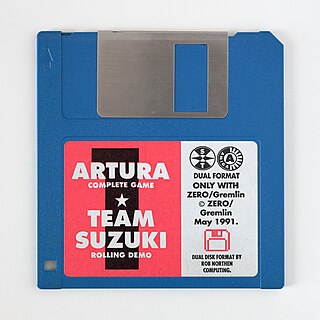 W
WA 5D DVD is an optical disc being developed by Peter Zijlstra, James Chon and Min Gu at the Swinburne University of Technology in Melbourne, Australia. In 2009, the developers estimated that the technology could be commercially ready in five to ten years.
 W
WArchival Disc (AD) is the name of a trademark owned by Sony Corporation and Panasonic Corporation describing an optical disc storage medium designed for long-term digital storage. First announced on 10 March 2014 and introduced in the second quarter of 2015, the discs are intended to be able to withstand changes in temperature and humidity, in addition to dust and water, ensuring that the disc is readable for at least 50 years. The agreement between Sony and Panasonic to jointly develop the next generation optical media standard was first announced on 29 July 2013.
 W
WBlu-ray Disc (BD), often known simply as Blu-ray, is a digital optical disc storage format. It is designed to supersede the DVD format, capable of storing several hours of video in high-definition. The main application of Blu-ray is as a medium for video material such as feature films and for the physical distribution of video games for the PlayStation 3, PlayStation 4, PlayStation 5, Xbox One and Xbox Series X. The name "Blu-ray" refers to the blue laser used to read the disc, which allows information to be stored at a greater density than is possible with the longer-wavelength red laser used for DVDs.
Blu-ray Disc Recordable (BD-R) refers to two direct to disc optical disc recording technologies that can be recorded on to a Blu-ray-based optical disc with an optical disc recorder. BD-R discs can be written to once, whereas Blu-ray Disc Recordable Erasable (BD-RE) can be erased and re-recorded multiple times. Disc capacities are 25 GB for single-layer discs, 50 GB for double-layer discs, 100 GB ("XL") for triple-layer, and 128 GB for quadruple-layer.
 W
WCompact disc (CD) is a digital optical disc data storage format that was co-developed by Philips and Sony and released in 1982. The format was originally developed to store and play only digital audio recordings (CD-DA) but was later adapted for storage of data (CD-ROM). Several other formats were further derived from these, including write-once audio and data storage (CD-R), rewritable media (CD-RW), Video CD (VCD), Super Video CD (SVCD), Photo CD, PictureCD, Compact Disc-Interactive (CD-i), and Enhanced Music CD. The first commercially available audio CD player, the Sony CDP-101, was released October 1982 in Japan.
 W
WA CD-ROM is a pre-pressed optical compact disc that contains data. Computers can read—but not write to or erase—CD-ROMs, i.e. it is a type of read-only memory.
 W
WClick of death is a term that had become common in the late 1990s referring to the clicking sound in disk storage systems that signals a disk drive has failed, often catastrophically.
 W
WCompact disc (CD) is a digital optical disc data storage format that was co-developed by Philips and Sony and released in 1982. The format was originally developed to store and play only digital audio recordings (CD-DA) but was later adapted for storage of data (CD-ROM). Several other formats were further derived from these, including write-once audio and data storage (CD-R), rewritable media (CD-RW), Video CD (VCD), Super Video CD (SVCD), Photo CD, PictureCD, Compact Disc-Interactive (CD-i), and Enhanced Music CD. The first commercially available audio CD player, the Sony CDP-101, was released October 1982 in Japan.
 W
WIn optical storage, constant angular velocity (CAV) is a qualifier for the rated speed of any disc containing information, and may also be applied to the writing speed of recordable discs. A drive or disc operating in CAV mode maintains a constant angular velocity, contrasted with a constant linear velocity (CLV).
 W
WIn optical storage, constant linear velocity (CLV) is a qualifier for the rated speed of an optical disc drive, and may also be applied to the writing speed of recordable discs. CLV implies that the angular velocity varies during an operation, as contrasted with CAV modes. The concept of constant linear velocity was patented in 1886 by phonograph pioneers Chichester Bell and Charles Tainter.
 W
WCylinder-head-sector (CHS) is an early method for giving addresses to each physical block of data on a hard disk drive.
 W
WDisk packs and disk cartridges were early forms of removable media for computer data storage, introduced in the 1960s.
 W
WDisk read/write heads are the small parts of a disk drive which move above the disk platter and transform the platter's magnetic field into electrical current or, vice versa, transform electrical current into magnetic field. The heads have gone through a number of changes over the years.
 W
WDisk storage is a general category of storage mechanisms where data is recorded by various electronic, magnetic, optical, or mechanical changes to a surface layer of one or more rotating disks. A disk drive is a device implementing such a storage mechanism. Notable types are the hard disk drive (HDD) containing a non-removable disk, the floppy disk drive (FDD) and its removable floppy disk, and various optical disc drives (ODD) and associated optical disc media.
 W
WIn computer science, a double-sided disk is a disk of which both sides are used to store data.
 W
WDual format is a technique used to allow two completely different systems software to reside on the same disk.
 W
WDVD is a digital optical disc data storage format invented and developed in 1995 and released in late 1996. The medium can store any kind of digital data and was widely used for software and other computer files as well as video programs watched using DVD players. DVDs offer higher storage capacity than compact discs while having the same dimensions.
 W
WDVD-Video is a consumer video format used to store digital video on DVD discs. DVD-Video was the dominant consumer home video format in Asia, North America, Europe, and Australia in the 2000s until it was supplanted by the high-definition Blu-ray Disc. Discs using the DVD-Video specification require a DVD drive and an MPEG-2 decoder. Commercial DVD movies are encoded using a combination MPEG-2 compressed video and audio of varying formats. Typically, the data rate for DVD movies ranges from 3 Mbit/s to 9.5 Mbit/s, and the bit rate is usually adaptive. DVD-Video was first available in Japan on November 1, 1996, followed by a release on March 24, 1997 in the United States—to line up with the 69th Academy Awards that same day.
 W
WA floppy disk or floppy diskette is a type of disk storage composed of a thin and flexible disk of a magnetic storage medium in a square or nearly square plastic enclosure lined with a fabric that removes dust particles from the spinning disk. Floppy disks are read from and written to by a floppy disk drive (FDD).
 W
WThe floppy disk is a data storage and transfer medium that was ubiquitous from the mid-1970s well into the 2000s. Besides the 3½-inch and 5¼-inch formats used in IBM PC compatible systems, or the 8-inch format that preceded them, many proprietary floppy disk formats were developed, either using a different disk design or special layout and encoding methods for the data held on the disk.
 W
WFluorescent Multilayer Disc (FMD) is an optical disc format developed by Constellation 3D that uses fluorescent, rather than reflective materials to store data. Reflective disc formats have a practical limitation of about two layers, primarily due to interference, scatter, and inter-layer cross talk. However, the use of fluorescence allowed FMDs to operate according to the principles of 3D optical data storage and have up to 100 data layers. These extra layers potentially allowed FMDs to have capacities of up to a terabyte, while maintaining the same physical size of traditional optical discs.
 W
WForward Versatile Disc (FVD) is an offshoot of DVD developed in Taiwan jointly by the Advanced Optical Storage Research Alliance (AOSRA) and the Industrial Technology Research Institute (ITRI) as a less expensive alternative for high-definition content. The disc is similar in structure to a DVD, in that pit length is the same and a red laser is used to read it, but the track width has been shortened slightly to allow the disc to have 5.4 GB of storage per layer as opposed to 4.7 GB for a standard DVD. The specification allows up to three layers for total of 15 GB in storage. WMV9 is used as the video codec allowing for 135 minutes of 720p video on a dual layer disc and 135 minutes of 1080i video on a three-layer disc. FVD uses AACS copy protection which is one of the schemes used in both HD DVD and Blu-ray Discs.
 W
WA hard disk drive (HDD), hard disk, hard drive, or fixed disk is an electro-mechanical data storage device that stores and retrieves digital data using magnetic storage and one or more rigid rapidly rotating platters coated with magnetic material. The platters are paired with magnetic heads, usually arranged on a moving actuator arm, which read and write data to the platter surfaces. Data is accessed in a random-access manner, meaning that individual blocks of data can be stored and retrieved in any order. HDDs are a type of non-volatile storage, retaining stored data even when powered off.
 W
WHard sectoring in a magnetic or optical data storage device is a form of sectoring which uses a physical mark or hole in the recording medium to reference sector locations.
 W
WHD DVD is an obsolete high-density optical disc format for storing data and playback of high-definition video. Supported principally by Toshiba, HD DVD was envisioned to be the successor to the standard DVD format.
 W
WThe Holographic Versatile Disc (HVD) is an optical disc technology developed between April 2004 and mid-2008 that can store up to several terabytes of data on an optical disc 10 cm or 12 cm in diameter. The company responsible for HVD went bankrupt in 2010, and the product was not launched.
 W
WThe Hyper CD-ROM is an optical data storage device similar to the CD-ROM with a multilayer 3D structure, invented by Romanian scientist Dr. Eugen Pavel.
 W
WLS-R, or the Layer-Selection-Type Recordable Optical Disk, is the term coined by Hitachi in 2003 for a next-generation optical disc technology which allows much larger data storage densities than DVD, HD DVD or Blu-ray Disc, by allowing the use of many data layers in a single disc. In previous optical disc technologies, relatively few data layers can be incorporated in a single disc, since the reflections from the different layers interfere with each other. However, in LS-R, only the layer of interest generates a reflection, meaning that very many layers can theoretically be stacked in the same disc. This feat is accomplished by an electronic "selection" mechanism, whereby each data layer is coated with electrodes and only the electrodes associated with the layer of interest are activated. This activation changes the "selected" data layer from being transparent to being reflective or opaque, thus it can be addressed.
 W
WLV-ROM is an optical disc format developed by Philips Electronics to integrate analog video and computer software for interactive multimedia. The LV-ROM is a specialized variation of the CAV Laserdisc. LV-ROM is an initialism for "LaserVision Read-Only Memory".
 W
WM-DISC is a write-once optical disc technology introduced in 2009 by Millenniata, Inc. and available as DVD and Blu-ray discs.
 W
WMovieCD is a format for digital video storage and consumer home video playback released in 1996 by Sirius Publishing, and was rendered obsolete by the wider distribution of DVD. It used a video codec called MotionPixels, marketed by MotionPixels, Inc., a subsidiary of Sirius Publishing. It was used in many third-party video games from the mid to late-1990s, and during the same time on Sirius's MovieCDs that it had been originally developed for, enjoying an international distribution in both forms.
 W
WTwo-dimensional magnetic recording (TDMR) is a novel technology recently introduced in hard disk drives (HDD) used for computer data storage. Most of the world's data is recorded on HDDs, and there is continuous pressure on manufacturers to create greater data storage capacity in a given HDD form-factor and for a given cost. In an HDD, data is stored using magnetic recording on a rotating magnetic disk and is accessed through a write-head and read-head. TDMR allows greater storage capacity by advantageously combining signals simultaneously from multiple read-back heads to enhance the recovery of one or more of data-tracks. In this manner, data can be stored with higher areal-density on the disks thus providing higher capacity in each HDD. TDMR is a read-back technology and thus applies equally well to future recording (writing) technologies such as Heat-Assisted Magnetic Recording (HAMR) and Microwave-Assisted Magnetic Recording (MAMR).
 W
WThe Stacked Volumetric Optical Disc is an optical disc format developed by Hitachi/Maxell, which uses an array of wafer-thin optical discs to allow data storage.
 W
WApple's SuperDrive is a CD/DVD reader/writer, introduced in 2001. It was previously a high-density floppy disk drive from 1988 to 1999, capable of reading all major 3.5″ disk formats.
 W
WA disk drive track is a circular path on the surface of a disk or diskette on which information is magnetically recorded and from which recorded information is read.
 W
WUltra Density Optical (UDO) is an optical disc format designed for high-density storage of high-definition video and data.
 W
WUltra HD Blu-ray (UHD-BD) is a digital optical disc data storage format that is an enhanced variant of Blu-ray. Ultra HD Blu-ray discs are incompatible with existing standard Blu-ray players. Ultra HD Blu-ray supports 4K UHD video at frame rates up to 60 progressive frames per second, encoded using High Efficiency Video Coding. The discs support both high dynamic range by increasing the color depth to 10-bit per color and a greater color gamut than supported by conventional Blu-ray video by using the Rec. 2020 color space. It is supported on Microsoft's Xbox One X and One S; the Xbox Series X and also on Sony's PlayStation 5 video game consoles.
 W
WVCDHD is an optical disc standard, similar to CD or DVD. The technology for VCDHD was invented with in: Japan, the Netherlands and Poland. Since the name of the technology is similar to the arbitrarily inferior VCD, it's also marketed using the name DVHD.
 W
WThe VideoNow is a portable video player produced by Hasbro and released by their subsidiary Tiger Electronics in 2003. The systems use discs called PVDs, which can store about 30 minutes of video, the length of an average TV show with commercials, so each PVD contains only one episode, with trailers at the end to use the leftover time on most PVDs, including Nickelodeon PVDs. Video data is stored on the left audio channel with audio on the right channel, thus making it impossible to achieve stereo sound on the system, which only plays in black and white. The video plays at about 15 frames per second. Most of the shows were from Nickelodeon, such as SpongeBob SquarePants and The Fairly OddParents, and later they released shows from Cartoon Network, such as Ed, Edd n Eddy and Dexter's Laboratory. A small amount of movies were also released on the system, but due to the limited space on a PVD, said movies would have to be released on at least three discs, depending on the length of said film.
 W
WThe Zip drive is a removable floppy disk storage system that was introduced by Iomega in late 1994. Considered medium-to-high-capacity at the time of its release, Zip disks were originally launched with capacities of 100 MB, then 250 MB, and finally 750 MB.
 W
WIn computer storage, zone bit recording (ZBR) is a method used by disk drives to optimize the tracks for increased data capacity. It does this by placing more sectors per zone on outer tracks than on inner tracks. This contrasts with other approaches, such as constant angular velocity (CAV) -drives, where the number of sectors per track are the same. On a disk consisting of roughly concentric tracks – whether realized as separate circular tracks or as a single spiral track – the physical track length (circumference) is increased as it gets farther from the centre hub.